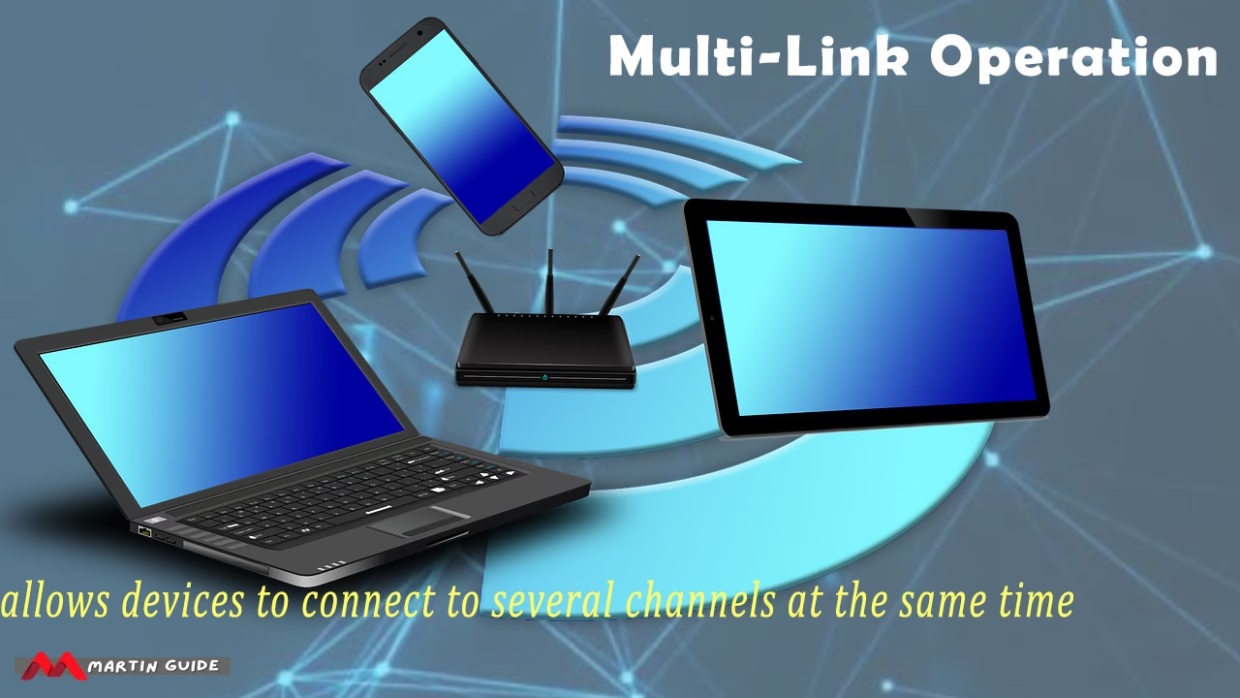
What Is Wi-Fi 7? Of course! Wi-Fi 7 technology is the new generation of wireless communication technologies (Wi-Fi), officially known as IEEE 802.11be. It is a significant improvement compared to previous Wi-Fi technologies such as Wi-Fi 6 and Wi-Fi 5 (802.11ac).
Wi-Fi 7 improves connection speeds, reduce latency, and increases the efficiency of wireless networks, especially in crowded environments.
The most prominent features of Wi-Fi 7 technology
Theoretical Wi-Fi 7 speeds reach 30-40 gigabits per second (Gbps), compared to 9.6 gigabits per second for Wi-Fi 6.
1. Super speeds:
- These high speeds are ideal for applications that require large data transfer, such as virtual reality (VR), cloud gaming, and high resolution (8K) gaming.
2. Reduce data congestion:
- Wi-Fi 7 fully supports the 6 GHz bandwidth, besides the traditional 2.4 GHz and 5 GHz bands.
- 6 GHz band provides wider channels (up to 320 MHz), allowing faster and more efficient data transfer.
3. Multi-Link Operation (MLO) technology:
This technology allows devices to connect to several channels at the same time through different frequencies (2.4 GHz, 5 GHz, and 6 GHz).
This increases reliability and reduces latency, which makes them ideal for delay-sensitive applications, such as games and video calls.
4. Improved performance in crowded places:
- wi fi 7 supports advanced technologies such as MU-MIMO (Multi-User Multiple Input Multiple Output) and OFDMA (Orthogonal Frequency-Division Multiple Access) better.
- These technologies allow multiple devices to connect to the network at the same time without performance degradation.
5. Reducing latency:
- wi fi 7 reduces access time to at least 1 millisecond sometimes.
- This is important for applications that require immediate response, such as online games, virtual reality, and controlling smart devices.
6. Optimization of energy consumption:
- Despite the increased speeds, Wi-Fi 7 is more energy efficient, which extends the battery life of mobile devices.
Benefits of Wi-Fi 7 for smart homes
- Support for a greater number of devices: With the increase in the number of smart devices in homes (such as cameras, smart refrigerators, lighting systems, and audio aids), Wi-Fi 7 provides a more stable connection.
- Improved user experience: high speeds and low access times make playing HD video and cloud games smoother.
- Integration with future technology: Wi-Fi 7 supports future applications such as augmented reality (AR) and artificial intelligence (AI).
So What Is Wi-Fi 7 difference between Wi-Fi 5 vs Wi-Fi 6 and Wi-Fi 6E
| Feature | Wi-Fi 7 (802.11be) | Wi-Fi 6E (802.11ax) | Wi-Fi 6 (802.11ax) | Wi-Fi 5 (802.11ac) |
| Max Speed | Up to 30-40 Gbps | Up to 9.6 Gbps | Up to 9.6 Gbps | Up to 3.5 Gbps |
| Frequency Bands | 2.4 GHz, 5 GHz, 6 GHz | 2.4 GHz, 5 GHz, 6 GHz | 2.4 GHz, 5 GHz | 5 GHz only |
| Channel Width | Up to 320 MHz | Up to 160 MHz | Up to 160 MHz | Up to 80 MHz |
| Latency | Less than 1 ms | Around 2-3 ms | Around 2-3 ms | Higher than 5 ms |
| MLO (Multi-Link Operation) | Supported (Connects to multiple channels simultaneously) | Not Supported | Not Supported | Not Supported |
| MU-MIMO | Supported (Enhanced) | Supported | Supported | Supported (Limited) |
| Performance in Crowded Areas | Best Performance | Good Performance | Good Performance | Lower Performance |
| Power Efficiency | Most Efficient | Highly Efficient | Highly Efficient | Less Efficient |
| Backward Compatibility | Supported (Lower speeds) | Supported (Lower speeds) | Supported (Lower speeds) | Supported (Lower speeds) |
| Ideal Applications | Cloud Gaming, VR, 8K Streaming, Smart Homes | Gaming, 4K Streaming, Smart Homes | Gaming, 4K Streaming, Smart Homes | 1080p Streaming, Basic Browsing |
| OFDMA | Supported (Enhanced) | Supported | Supported | Not Supported |
Explanation of the Table:
1-Max Speed:
- Wi-Fi 7 is the fastest, with speeds up to 30-40 Gbps, while Wi-Fi 5 is the slowest with speeds up to 3.5 Gbps.
2-Frequency Bands:
- Wi-Fi 7 and Wi-Fi 6E support the 6 GHz band, providing wider channels and better performance.
- Wi-Fi 6 supports 2.4 GHz and 5 GHz only.
- Wi-Fi 5 supports 5 GHz only.
3-Channel Width:
- Wi-Fi 7 supports channels up to 320 MHz, allowing for faster data transfer.
- Wi-Fi 6E and Wi-Fi 6 have latency around 2-3 ms.
- Wi-Fi 5 has higher latency.
4-MLO (Multi-Link Operation):
- Only wi fi 7 supports MLO, which allows devices to connect to multiple channels simultaneously.

Image credit:pixabay
6-MU-MIMO and OFDMA:
- Wi-Fi 7, Wi-Fi 6E, and Wi-Fi 6 support these technologies to improve performance in crowded environments.
- Wi-Fi 5 supports MU-MIMO in a limited way and does not support OFDMA.
7-Performance in Crowded Areas:
- Wi-Fi 7 offers the best performance in crowded areas thanks to enhanced MU-MIMO and OFDMA.
- Wi-Fi 6E and Wi-Fi 6 also perform well.
- Wi-Fi 5 is less efficient in crowded environments.
8-Power Efficiency:
- Wi-Fi 7 is the most power-efficient, followed by Wi-Fi 6E and Wi-Fi 6.
- Wi-Fi 5 is less efficient.
9-Backward Compatibility:
- All generations are backward compatible with older devices, but at lower speeds.
10-Ideal Applications:
- Wi-Fi 7 is ideal for future applications like cloud gaming and VR.
- Wi-Fi 6E and Wi-Fi 6 are great for gaming and high-definition streaming.
- Wi-Fi 5 is suitable for basic uses like browsing and 1080p streaming.
In short
Wi-Fi 7 offers blazing speeds (up to 40 Gbps), ultra-low latency (<1ms), and superior performance in crowded areas. It’s ideal for gaming, VR, 8K streaming, and smart homes. However, it requires new devices and routers, making it a future-proof but costly upgrade. If you need cutting-edge performance now, it’s worth it; otherwise, Wi-Fi 6/6E may suffice.











Be the first to leave a comment